
Recommendations from the French Telecommunications Regulatory Authority (ART) related to the Spectrum Management Plan (Plan de Gestion du Spectre - PGS) for the deployment of broadband services on the local loop
18th June 2001
 Download the recommandations
Download the recommandations 
 Version française
Version française 
|
Table of contents 1°) Introduction Non-discrimination Principles
4°) Retained PSD MasksEfficiecy Principle Principle for Introducing New Technology in the Local Loop References Annex : Frequency Masks of Stabdardised Systems Authorised for Use that Contribute to Reference Mask Development |
In accordance with the decree issued on 12th September 2000 related to local loop access, unbundling has been effective since 1st January 2001.
To make implementation of local loop access easier, the Authority set up a working group in February 2000 that brought together the various players in the market. Based on this group’s work, which specified the technical and operational methods for local loop access, on 30th October 2000, the Authority published a number of recommendations for implementing completely unbundled local loop access. These initial recommendations were aimed at creating a reference framework that would facilitate development of negotiations between France Telecom and the operators for implementing the unbundling. The recommendations were completed on 22nd December 2000 with the definition of local loop access sharing services and operational implementation thereof.
These recommendations could not, however, deal with aspects related to the Spectrum Management Plan (PGS) that had not yet been studied by the working group. Since then, it has carried out work dealing with this question and the Authority is in a position to complete its initial recommendations.
The working group, which is chaired by Alain Bravo and brings together France Telecom, the operators and some manufacturers, is considered useful for introducing measures for limiting the risks of disruption on the cables that may be generated through the co-existence of various broadband services. A method based on the definition of masks and frequencies has been retained. The benefit of this method is that it makes it unnecessary to study each of the technologies and gives visibility to the operators and the industrialists.
The working group has drawn up two documents to outline the essential tasks concerning the technical plan. These documents are as follows:
- A notice concerning the PSD (Power Spectral Density) gauges and the transmission systems authorised within the scope of France Telecom’s Telecom’s local loop access.
- Recommendations for the Spectrum Management Plan.
The specifications provided by these documents will allow the technologies accepted for the deployment of broadband services to be determined, thanks to the definition of a couple of frequency masks. They will also allow the updating processes for such system to be defined according to changes in the transmission technologies and the interest in their deployment.
The first paragraph of Article 1 of the CE 2887/2000 European regulations, dated 18th December 2000 stipulates the following: "This regulation aim at intensifying competition and stimulating technological innovation in the local access market, through the setting of harmonised conditions for unbundled access to the local loop, to foster the competitive provision of a wide range of electronic communications services "
The technological innovation mentioned in the rules will materialise when the operators introduce new technologies aimed at supporting higher performance services.
Additionally, the second line of Article 3.2 stipulates the following: "requests shall only be refused on the basis of objective criteria, relating to technical feasibility or the need to maintain network integrity".
Article D 99-23 of decree number 2000–881, dated 12th September 2000 stipulates that: "the operators (notified) are required to respond in accordance with objective, transparent and non-discriminatory criteria, to reasonable demands for access to the local loop".
In the same text, Article D 99-26 declares Article 99-7 applicable to "respecting essential demands and, in particular, the security of network operation and maintenance of network integrity".
Also, implementation of local loop access must not introduce constraints that would not be justified by preservation of network integrity, for either technologies or equipment that may be used by the operators.
The main aim of the PGS is to make the largest possible amount of data pass through the cables in an optimal manner, on each pair of copper cables, in particular ensuring good operation of each of the services supported and limiting interference between lines.
The PGS must authorise the maximum deployable technical configurations complying with the pre-established PSD masks. It must give each operator full flexibility in developing the broadband services.
This method must ensure it does not limit the service area that may be proposed by the operators to those areas already supplied by France Telecom, with no opportunity for innovation. It must allow the basis upon which access may be refused to be defined objectively.
3.1) Non-discrimination Principle
The PGS is a specification that must be followed by all the operators using the local copper loop for deployment of xDSL technologies and broadband services. This includes France Telecom. It must allow the best combination between all the operators’ service needs and business plans.
Implementation of local loop access must not introduce constraints that would not be justified by preservation of network integrity, for either technologies or equipment that may be used by the operators. Such constraints or restrictions that are not based on objective criteria showing that such available technologies may harm the efficient operation of the network, could limit the service areas that can be proposed by the operators.
3.2.1) Pair Management
Management of the pairs is deemed impossible by most of the operators. This is due to the fact that the existing databases are not automated or updated (e.g., change in pair use), as well as the fact that the information contained in these databases is often incomplete or inaccurate. The PGS must free up this state of affairs so that the operators can deploy a technology on a copper pair regardless of the location of this pair in the cable.
3.2.2) Cable Usage
Taking the problems with pair management into account, most, but not all of the spectrum management processes examined in industry forums have adopted 100% broadband technology use for the cables.
3.2.3) Line Length
The characteristics of France Telecom’s local loop are supervised by the working group, defining the same PGS for all pairs, regardless of their length.
3.2.4) Technologies
The PGS must authorise the maximum number of deployable technology configurations in accordance with the established spectral mask limits. This gives each operator flexibility in developing access services, which also allows it to differentiate itself from other operators. The PGS must only work with standardised or near-standardised technologies.
3.2.5) Existing Technologies
Although existing systems have been taken into account, this does not mean that planning rules for them may not be questioned by the PGS.
The PGS must be based on the technological merits of infrastructure aimed at the future. Existing technologies can thus be reviewed according to their impact on the PGS. In the case of an existing technology creating significant disruptions in the performance of the new xDSL deployed technology, a programme should be initiated to remove this technology from the network.
3.2.6) PGS Modification
The PGS is managed by the Authority. A group of experts brings the present operators in the local loop together and the manufacturers help with this task. The experts will, in particular, be in charge of making rulings, under the guidance of the Authority, on changes to the PGS.
Modification of the PGS may take place:
- During the introduction of a new technology if it does not come within the PSD mask
- During withdrawal of an obsolete technology from the authorised technologies list
- During a change to an existing technology when this change requires a modification to the PSD mask
During the PGS modification processes, the authorised and deployed technology list is examined in a way that ensures coherence of the unit.
3.3) Principle for Introducing New Technology in the Local Loop
Technologies that can be deployed by the operators must come within the current PSD mask recommended by the Authority. They must be standardised beforehand and be compatible with already implemented technologies.
France Telecom should update and distribute the list of technologies used in the local loop (technologies deployed by France Telecom and/or the participating operators) upon request of the operators so that these operators can be assured that a planned new technology will be compatible with already existing ones.
3.3.1) Technology Standardised compatible with the PGS
An operator that is a signatory to the access agreement, may deploy standardised technology (ETSI, UIT) that complies with the PSD masks, whatever its output configuration, and as long as this technology is compatible with technologies implemented beforehand.
For this reason, the operator informs France Telecom about the technology already implemented (current regulations, technical specifications of the equipment deployed).
In the event of this new technology turning out to be incompatible with the already implemented technologies, a contradictory analysis is carried out under the guidance of France Telecom and in the presence of the team of the operator concerned. This analysis allows technical feasibility, preservation of network integrity and implemented services to be checked.
3.3.2) Non-standardised Technology Compatible with the PGS:
In the case of an operator that is a signatory to the access agreement wishing to deploy a non-standardised technology that complies with the PSD masks, whatever its bit rate configuration, tests must be able to be carried out by the operator on the France Telecom network. A contradictory analysis must indicate whether the technology can be deployed or not, with regards to technical feasibility, preservation of network integrity and services already implemented.
To do this, the operator must register a technical file with France Telecom, which details the technical specifications for the planned equipment and the works being carried out in the standardisation groups for the new technology to be introduced into the local loop.
France Telecom will communicate its decision and reasoning to the operator making the request, within a maximum of two months after the implementation of the test, regarding whether or not the new technology will be used in the local loop. In the event of the technology being used, generalisation may only take place after publication of the standard (ETSI or UIT).
Tests implemented will be technical and thus be limited to very few sites (1 or 2 sites) and will have a limited number of unbundled pairs (around 100 lines per site).
In order to carry out laboratory tests alongside the tests, as well as studies that simulate the impact of introducing this new technology and that study the performance of systems deployed in the local loop, France Telecom must ask the operator to lend the equipment corresponding to this new technology.
3.3.3) Technology Non-compatible with the PGS:
An operator that is a signatory to the access agreement, which wishes to introduce a new technology that is not compatible with the current PSD masks, must first of all request a modification to these masks.
To do this, the operator registers a technical file with an expert group made up of operators that are signatories to the access agreement, France Telecom and the manufacturers. This group will meet under the guidance of the Authority in order to objectively evaluate the technical feasibility and the consequences that eventual deployment of this new technology will have on network integrity and already existing services.
During examination of the technical file, the group examines the list of technology already deployed in the local loop in order to ensure coherence of the unit.
Two months after the file has been received, the group of experts makes a decision on how justified the request is and eventually modifies the frequency masks in force, as recommended by the Authority.
In the event of the PSD mask being modified, the tests must be implemented in accordance with the procedures specified in the preceding chapter.
In order to comply with the non-discrimination principle, France Telecom may only deploy a new technology that does not comply with the current PSD mask after consulting the group of experts and after a modification to the mask has been made.
The retained power mask have been built taking into account the overall budget for the different masks that serve as a reference and are reported in the annex. The PSD mask take into account all the technologies that are known and/or proven not to be problematic. Among the different technologies within the same area of interest (similar services provided, comparable transmission performances), the PSD mask only retain the least disrupting technologies as a priority.
In order to be accepted for deployment, a standardised technology must, among other matters, comply with the PSD masks (upstream and downstream channels) whatever its bit rate configuration.
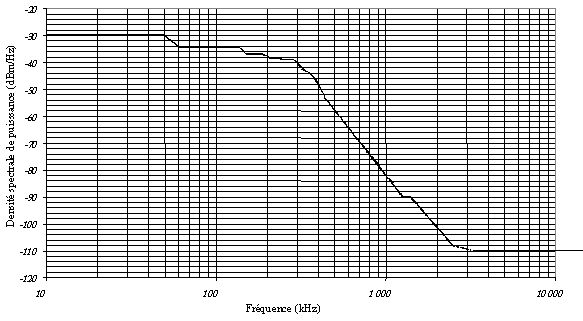
Diagram 1: Upstream Channel Mask
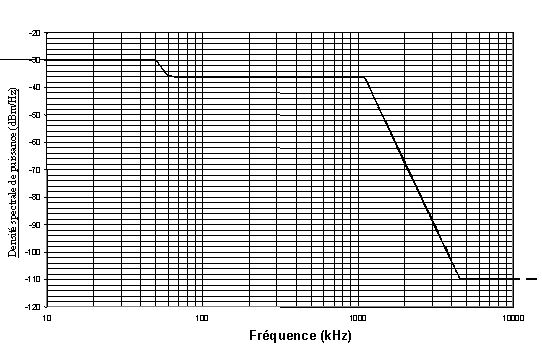
Diagram 2: Downstream Channel Mask
For example, the systems authorised for use in France are the standard ETSI and ITU systems [references 3, 4 and 6 to 9] specified below:
- Analogue telephone (POTS)
- Basic band connection
- RNIS and IDSL / 2B1Q [6],
- ADSL/POTS and ADSL Lite [8 and 9],
- SDSL ETSI [3],
- G.SHDSL (ITU European annex) [4],
- HDSL 2 or 3 2B1Q modulation pairs [7],
- HDSL 2 CAP modulation pairs [7].
The following is a list of the technologies rejected:
- ADSL/RNIS
- HDSL2
- HDSL on a pair
- SDSL 2B/1Q
These technologies are lower performance, are pollutants and are outside the PSDmask.
[1] OFTEL (06/2000): Access to Bandwidth; Proposed Solution for the Access Network Frequency Plan (ANFP) for BT Metallic Access Network
[2] STFT08 (13/10/00): Gabarit PSD/systèmes de transmission envisageables dans le cadre de l’accès à la boucle locale, Groupe Spécifications Techniques
[3] ETSI TS 101 524-2 V1.1.1 (2000-06): Symmetrical single pair high bit rate Digital Subscriber Line (SDSL); Part 2: Transceiver requirements
[4] ITU G.991.2 (ex G.shdsl): Draft Recommendation, 08/2000, Huntsville Canada
[5] NICC Issue 1 (May 99): Conclusions of the NICC DSL Task group
[6] ETSI TS 102 080 (V1.3.2): Transmission and Multiplexing, Integrated Services Digital Network (ISDN) basic rate access; Digital transmission systems on metallic local lines
[7] ETSI TS 101 135: Transmission and Multiplexing, High bit-rate Digital Subscriber Line (HDSL) transmission systems on metallic local lines; HDSL core specification and applications for combined ISDN-BA and 2048 kbits/s transmission
[8] ITU Recommendation G.992.1 (06/99); Asymmetric Digital Subscriber Line (ADSL) transceivers
[9] ITU Recommendation G.992.2(06/99); Splitterless Asymmetric Digital Subscriber Line (ADSL) transceivers
Frequency Masks of Standardised Systems Authorised for Use that Contribute to Reference Mask Development
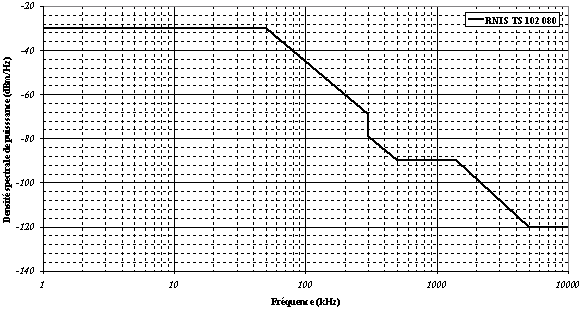
Diagram 1: RNIS Mask [ref 6]
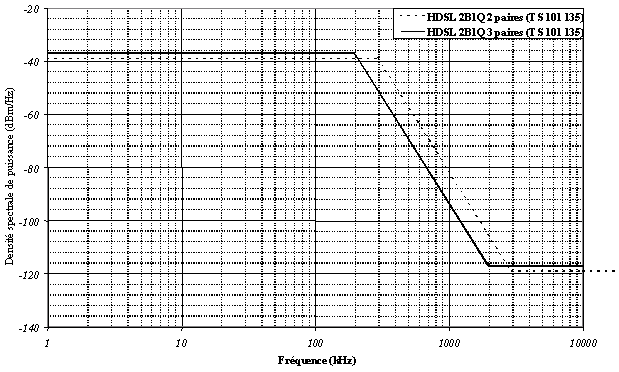
Diagram 2: HDSL 2B1Q Masks (2 and 3 pairs) [ref 7]
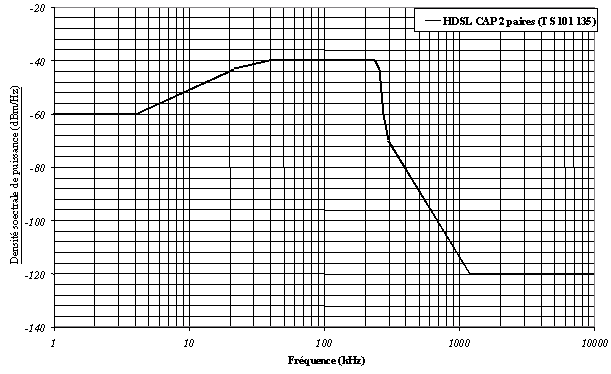
Diagram 3: HDSL CAP Masks (2 pairs) [ref 7]
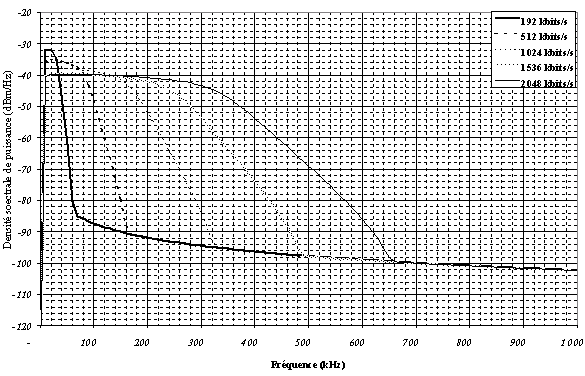
Diagram 4: Symmetrical SDSL Masks [ref 3]
(192 kbits/s, 512 kbits/s, 1024 kbits/s, 1536 kbits/s, 2048 kbits/s)
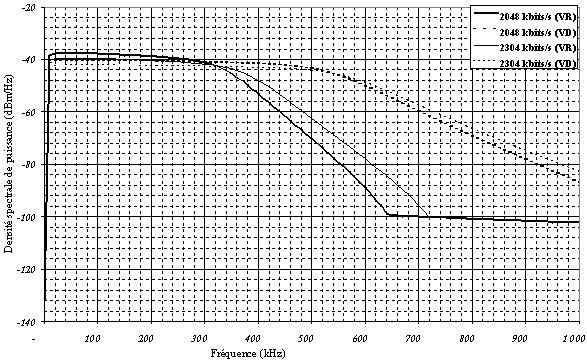
Diagram 5: Asymmetrical SDSL Masks [ref 3]
2048 kbits and 2304 kbits/s
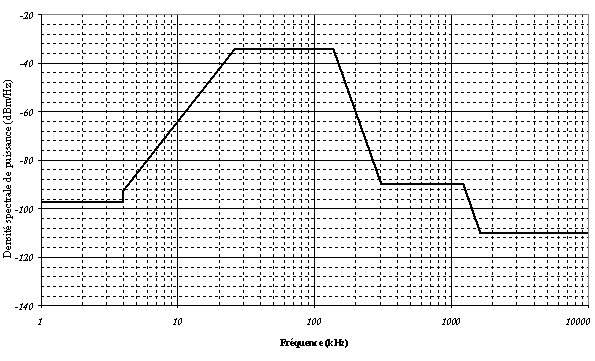
Diagram 6: ADSL/POTS or Lite Mask [ref 8,9]
(Upstream channel)
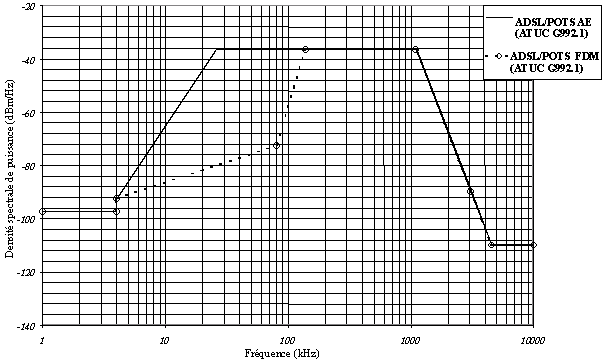
Diagram 7: ADSL/POTS Mask [ref 8]
(Downstream Channel)
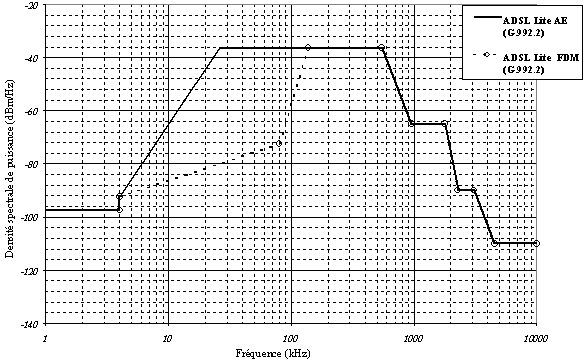
Diagram 8: Expressions of ADSL Lite [ref 9]
(Downstream Channel)

|
7, Square Max Hymans - 75730 PARIS Cedex 15
Téléphone : +33 1 40 47 70 00 - Télécopie : +33 1 40 47 71 98